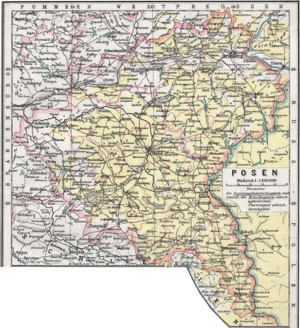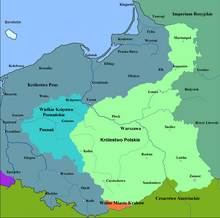|
Grand Duchy of Posen
The Grand Duchy of Posen (German: Großherzogtum Posen; Polish: Wielkie Księstwo Poznańskie) was part of the Kingdom of Prussia, created from territories annexed by Prussia after the Partitions of Poland, and formally established following the Congress of Vienna in 1815. On 9 February 1849, the Prussian administration renamed the grand duchy the Province of Posen. Its former name was unofficially used afterward for denoting the territory, especially by Poles, and today is used by modern historians to refer to different political entities until 1918. Its capital was Posen (Polish: Poznań). The title of Grand Duke of Posen remained until 1918 to the King of Prussia. HistoryBackground Originally part of the Kingdom of Poland, this area largely coincided with Greater Poland. The eastern portions of the territory were taken by the Kingdom of Prussia during the Partitions of Poland; during the first partition (1772), Prussia took just the Netze District, the portion along the Noteć (German: Netze) river. Prussia added the remainder during the second partition in 1793. Prussia briefly lost control during the Kościuszko Uprising in 1794. It was initially administered as the province of South Prussia. The Poles were the primary ally of Napoleon Bonaparte in Central Europe, participating in the Greater Poland Uprising of 1806 and supplying troops for his campaigns. After the defeat of Prussia by Napoleonic France, the Duchy of Warsaw was created by the Treaty of Tilsit in 1807. 1815–1830Following the Congress of Vienna, portions of the Prussia's Polish territories were ceded to Congress Poland, a kingdom ruled in personal union by the Russian Czar. From the remainder the Grand Duchy of Posen was created with the city of Posen as the administrative centre and the seat of the Statthalter Prince Antoni Henryk Radziwiłł. In reality the governing power over the region lay with the provincial upper-president Joseph Zerboni di Sposetti.[1] At the beginning of the Prussian takeover of Polish territories, the discrimination and repression of Poles consisted of reducing their access [citation needed] to education and the judicial system. Prussian officials identified Germanisation as the progress of higher culture over a lower one. As a result, the local administration discriminated against Poles. After 1824 attempts to Germanise the school system were hastened and the government refused to establish a Polish university in Posen. Polish politicians issued protests against Prussian policies and a secret, patriotic Polish organisation was founded called Towarzystwo Kosynierów (Society of Scythemen). Resistance activity of Poles resulted in reaction from Berlin, where a trial was held in connection to links between Poles from the Grand Duchy with Poles from Russian-ruled Congress Poland.[2] 1830–1840The 1830 November Uprising within Congress Poland against the Russian Empire was significantly supported by Poles from the Grand Duchy. Afterward, the Prussian administration under Oberpräsident Eduard Flottwell known for his anti-Polonism[1] introduced a stricter system of repression against the Poles. Prussian authorities attempted to expel Poles from administration to weaken the Polish nobility by buying its lands out, and, after 1832, the role of the Polish language in education was significantly repressed. Local self-government in the landed estates of land-lords, which was dominated by Polish nobility, was abolished, and instead the Prussian state appointed commissioners. Monasteries and their assets were confiscated by Prussia.[1] The office of the governor (Statthalter) was abolished. Germanisation of institutions, education as well through colonisation was implemented.[3] 1840–1846On September 11, 1840, an audience was held by the Prussian king for deputies coming from the Grand Duchy. Count Edward Raczyński, in the name of all Polish members of the Grand Duchy Sejm (parliament), issued a complaint against the repression and discrimination of the Polish population which went against guarantees made in 1815. He accused the Prussian authorities of removing the Polish language from public institutions, courts and schools, as well as deleting the history of Poland from school teaching and substituting the name "Province of Posen" for the previous "Grand Duchy of Posen". He also blamed the authorities for erasing the Polish Eagle from the Grand Duchy's seals and emblems and for expelling Poles from offices in order to replace them with Prussians or foreign-born persons of German ethnicity.[4] When land owners of Polish ethnicity sold land, it was often bought in order to resell it to colonists of German ethnicity. The Prussian king rejected the complaint; he was fully supportive of the Germanisation of Polish areas. However, he believed it had to be done through different methods, and in May 1841 decided to name Flottwell upper-president of the Prussian Province of Saxony, which included large territories annexed from the Kingdom of Saxony in 1815. Greater Poland Uprising of 1846Before 1848, repressions intensified in the Grand Duchy, censorship was strengthened, settlers of German ethnicity were brought in.[5] Large patriotic demonstrations were held in memory of Antoni Babiński, a member of the Polish Democratic Society. He had been wounded by a gunshot, when the Prussian gendarme attempting to arrest him, engaged in a fight with him. Babiński was then captured, sentenced to death and executed in Posen. His public execution in February 1847 was accompanied by public mourning. Cloth soaked in his blood and other remains were distributed as national relics. Large prayers were held in his memory, often against orders of Prussia. Members of such gatherings were persecuted by police.[5] At the same time the national self-awareness grew among the rural population of Polish and German ethnicity alike. Whereas two thirds of the grand ducal population identified as ethnically Polish (mostly in the centre, south and east), one third envisioned themselves as being of German ethnicity. Anti-Prussian sentiment grew as response to policy of Germanisation and repression by Prussian authorities and the conspiracy organisation called Związek Plebejuszy found a potent ground. It was led by bookseller Walenty Stefański, poet Ryszard Berwiński and lawyer Jakub Krauthofer-Krotowski.[5] Frankfurt Parliament of 1848 and the DuchyDuring the Revolutions of 1848, the Frankfurt Parliament attempted to divide the grand duchy into two parts: the Province of Posen, which would have been annexed into an united Germany, and the Province of Gniezno, which would have remained outside Germany, but because of the protest of Polish parliamentarians these plans failed and the integrity of the grand duchy was preserved. However, on February 9, 1849, after a series of broken assurances, the Prussian administration renamed the grand duchy the Province of Posen. Nevertheless, the territory remained outside of the German Confederation until its dissolution and but was incorporated into the North German Confederation upon its foundation. The Prussian kings retained the title of Grand Duke of Posen until the fall of the monarchy in 1918. Area and Population Posen Bromberg The grand duchy was 28,951 square kilometres (11,178 sq mi) in area and was subdivided into two government districts: Posen and Bromberg. The regions were further divided into 26 original districts (German: Kreis(e), Polish: Powiat(y)) headed by Landräte ("district councillors"). Later, these were redivided into 40 districts, plus two urban districts. In 1824, the Grand Duchy also received a provincial council (term started in 1827) but with little administrative power, limited to providing advice. In 1817, the Culmerland (Chełmno Land) was moved to West Prussia. From the 1820s, the grand duchy had a parliament, the Sejm of the Grand Duchy of Posen. Today much of the territory lies within the Greater Poland and Kuyavian–Pomeranian voivodeships. Population:
Since in the first half of the 19th century there was no census or other statistics also recording the ethnic identities of the inhabitants of the grand duchy[6] its ethnic composition can only be derived from its religious makeup then recorded in the census. By 1815 in the grand duchy Catholics were by majority Polish-speaking, most Protestants were native speakers of German and many Jews then spoke Yiddish. Based on the religious data it was estimated that in 1815 ethnic Poles made up about 657,000 persons (or 73% of the overall population), while ethnic Germans were 225,000 (25%) and 18,000 (or 2%) were of the Yiddish culture.[7] In 1819, according to Georg Hassel ethnic Poles were 77% of the population, ethnic Germans 17.5% and Jews 5.5%.[8] Whereas in 1812 Jews in then Prussia proper had been emancipated and naturalised, the Jews of the grand duchy were excluded from citizens franchise, but like women and non-propertied classes mere subjects of the grand duke. Only Christian men, if owning land, were enfranchised as citizens. Whereas Christians had freedom of moving from the grand duchy to Prussia proper, the grand duchy's Jews were forbidden to immigrate into Prussia.[9] Prussian policy, however, opened an exception, Germanized Jews were enfranchised as citizens and granted freedom of movement. So most adherents of the Yiddish culture Germanized themselves within a short period.[citation needed] Many traditional or newly established German language educational institutions were attended by local Jews who, equipped with Prussian education and German language skills, often emigrated to Prussia proper with some making their careers.[10] Despite Germanization efforts, the Polish speaking population more than doubled to 1,344,000 and remained the majority, however, its percentage decreased to 64% of the population by 1910.[1] However, there were regional differences, with Polish being the prevalent language in central, eastern and southern Posen, and German speakers constituted majorities in the north and west. ReligionAccording to contemporary statistics of 1825 the population consisted of the 65.6% Roman Catholics, 28.1% Protestants and 6.3% Jews.[11] The Roman Catholic congregations formed part of the Ecclesiastical Province of Gnesen-Posen led by the Primate of Poland, a Roman Catholic jurisdiction formed in 1821 by merging the archdiocese of Gniezno and Poznań. The bulk of the Lutheran and Reformed (Calvinist) congregations became part of the Ecclesiastical Province of Posen within the Evangelical Church in Prussia after 1817, with the congregations usually retaining their previous separate confessions. With the persisting resistance of some Lutherans against the administrative Prussian Union of churches, the Evangelical Lutheran Church in Prussia emerged in 1841. It was recognized by the government in 1845, with about 3,000 Old Lutherans in several congregations spread across the area of the grand duchy.[12] Jewish religious life was organised in about 130 congregations spread all over the grand duchy.[13] Since the government tolerated Judaism, but did not recognise it,[citation needed] no Jewish umbrella organisation, comparable to those of the Christian denominations or the former Council of Four Lands, forbidden in 1764, did emerge in the grand duchy.[13] The migration of Posen Jews to Prussia was mostly blocked until 1850, when they were finally naturalised.[9] Territorial administrationThe monarch of the grand duchy, with title of Grand Duke of Posen, was the Hohenzollern king of Prussia and his representative was the Duke-Governor (Statthalter): the first was Prince Antoni Radziwiłł (1815–1831), who was married to Princess Louise of Prussia, the king's cousin. The governor was assigned to give advice in matters of Polish nationality, and had the right to veto the administration decisions; in reality, however, all administrative power was in the hands of the Prussian upper-president of the province. OrganizationsOrganizations for items of general interest or province-wide purposes:
Polish organisations
German organisationsOrganisations aiming at promoting German-speaking culture, settlements, or expressively addressing German-speaking audiences:
Notable people
See alsoReferences
Sources
External links
|
||||||||||||||||||||||||||||||||||||||||||||||||||||||||||||||||||||||||||||||




